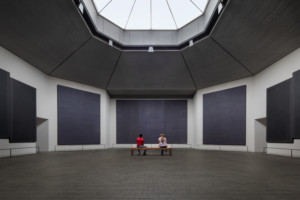3D printing company ICON opened its first model home for the Bjarke Ingels Group (BIG)–designed single family development as part of Wolf Ranch in Georgetown, Texas this past weekend. Located north of Austin, the development, built by Lennar, has a layout familiar to suburbanites across the U.S. The catch is that all 100 homes are 3D-printed with a concrete polymer, lavacrete, making this an attempt at a 21st-century Levittown.
AN reported on ICON’s activity in Wolf Ranch when construction broke ground last year, when ICON announced that they were building the largest 3D-printed community in the world. Dubbed the “Genesis Collection,” the homes at Wolf Point are being built from eight different floorplans: Dyce; Cato; Jorn; Nola; Ezra; Rune; Nye; and Clay. The plans are three- and four-bedroom, two-bath homes ranging from 1,574 to 2,112 square feet. Sales for the homes began last month, with the least expensive options coming in at $475,000 and highest at $599,000. Potential buyers will be able to choose from 24 different elevations that all bear the distinct look of an ICON-printed home.

ICON is pitching the homes as achieving a high level of operational efficiency. All models come with all-weather photovoltaic roof panels on standing seam metal roofs. Additionally, the machines the company is using to print the homes, accumulate very little construction waste on-site, and have tight envelopes. ICON’s tests show that the lavacrete has a high level of structural durability, minimizing long-term maintenance levels.
At least four homes have sold to date, and ICON told AN that 33 percent of the wall systems have been printed, with 80 of the 100 buildings currently under construction. The Genesis Collection will be part of the larger Wolf Ranch development being developed by suburban masterplan specialists Hillwood Communities, a Perot company (yes, that Perot). Hillwood touts the neighborhood as being sustainable, despite being fully designed for personal car use, and will only include 3D-printed homes in ICON/Lennar’s section, whereas the rest of Wolf Ranch will be built with otherwise standard construction methods.

While the exteriors are shaped by lavacrete and metal roofs, the interiors are smoother, complete with painted white ceilings, polished concrete floors, and some 3D-printed elements, like kitchen islands.
ICON is also working with BIG on a development in Marfa, Texas, El Cosmico, that also includes a hotel, and is conducting its own lunar and martian habitation research. ICON has previously built homes in East Austin, and with Lake|Flato.
In part a product of how development works, in part because ICON is focused on developing technology rather than serving as a realtor, ICON (and BIG and Lennar)’s model serves as an updated, less-integrated Levittown. While the lavacrete and its printing process are eye-catching, its housing production process follows in the footsteps of other American and Texan predecessors, whether it be the ubiquitous Sears Modern Homes or more experimental and less commercially successful Longview Homes.

What is significantly different is the labor—while there are workers on-site, and aspects of the models, like fit-out and photovoltaic panels cannot be printed on, a bulk of construction labor is shifted to the machine. In 1948, Harper’s reported on the early stages of Levittown, New York, saying: “The actual building techniques used by Levitt, of course, are not those of which a carpenter’s guild would be likely to approve. He uses time and labor-saving machinery whenever possible, even when such use (as paint sprayers) is specifically forbidden by the union.”
While ICON’s homes are more durable, and crucially, not a product of vertical integration, the shift to the machine is hard to ignore. ICON may produce a higher quality of work, but it is still confined within Wolf Point’s all-too-familiar urban form.











